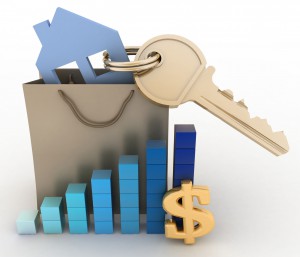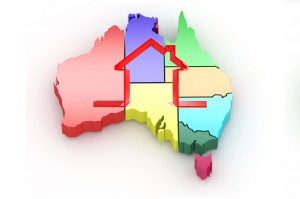According to the CoreLogic Home Value Index results out today, dwelling values edged lower across most capital cities over the month, with broad based falls weighing down dwelling values nationally for the fifth consecutive month. 
The 0.1% decline in national dwelling values in February 2018 was more moderate than the 0.3% declines recorded over each of the previous two months, however, it marked the first time national values had fallen for five consecutive months since March 2016.
There continues to be a divergence between capital city and regional markets, with the combined capital city index falling by -0.3% over the month, compared to a 0.4% increase in combined regional values.

Month-on-month falls were generally mild but broad based Over the month, values fell across every capital city except Hobart (+0.7%) and Adelaide (steady), with the largest monthly decline recorded across Darwin (- 0.9%) and Sydney (-0.6%).
Values were lower in Melbourne (-0.1%), Brisbane (-0.1%), Perth (-0.2%), and Canberra (-0.3%).
The rate of decline eased over the second half of February although values have fallen in most capital cities during February, the CoreLogic daily index indicates that the rate of decline eased late in the month, in line with improving auction clearance rates.

Sydney, Melbourne and Perth all recorded more moderate falls in values throughout February than they did in January.
The overall softening in the market becomes more evident when looking at the change in values over the past three months.
Over the three months to February 2018, Adelaide (0.1%) and Hobart (3.2%) were the only capital cities in which values rose.
Sydney, which has been the strongest market for value growth over recent years, saw the largest fall in values over the three month period, down -2.4%. Sydney was followed by Darwin, which has been persistently weak over recent years, and saw values fall by a further -2.0% over the quarter.
Regional markets outperforming the capitals.
While most individual capital cities recorded declines in values over the past three months, in the regional areas of the country the results were very different; regional dwelling values increased by 0.9% over the three months and values were higher in the regional areas of all states except for Western Australia.

Looking at the trends in housing markets on an annual basis, over the 12 months to February 2018, national dwelling values increased by 2.2%, which is their slowest annual rate of growth since August 2016. 
The gap between annual growth rates across the combined capital cities (2.0%) and the combined regional markets (2.8%) has continued to widen over the past month as regional areas outperform the capitals.
Sydney dwelling values slip into negative annual change for the first time since 2012 Looking at the individual capital cities, the most noteworthy development was for Sydney, where dwelling values moved into negative annual growth for the first time since 2012, down -0.5% over the past twelve months.
The only other capital cities where values were lower over the previous twelve month period were Perth (-2.7%) and Darwin (-7.4%) both of which have been in a sustained downturn since 2014.
While the rate of decline has clearly tapered in Perth, Darwin dwelling values remain in a consistent downwards trend.
Across the remaining capital cities, the annual rate of growth has continued to slow in all cities except for Hobart, where dwelling values are now 13.1% higher over the past twelve months.
Outside of the capital cities, regional New South Wales (5.7%), regional Tasmania (5.5%), regional Victoria (4.3%), regional Northern Territory (1.6%) and regional Queensland (0.5%) have each recorded increases in values over the past year.
In regional South Australia and regional Western Australia values have fallen by – 0.1% and -4.7% respectively.

Although dwelling values have been falling over the past three months, rental rates have been increasing over the same period. 
In fact, rental rates are higher over the year in all capital cities other than Perth and Darwin and within all regional markets except for regional Western Australia.
The markets experiencing the greatest increases in rents over the past year have been Hobart (10.2%) which has recorded double-digit annual rental growth for the first time since August 2009 and regional Tasmania (7.6%) which is experiencing the strongest rental growth since the end of 2008.
With the recent value declines, most capital city and regional markets are seeing values below their previous end of month peaks.
Nationally, values are – 0.8% below their September 2017 peak, with combined capital city values -1.3% lower while combined regional market values reached a new historic high last month. 
Across the individual capital cities, Hobart is the only city in which values remain at a historic high, with values below their peak levels in Sydney (-3.7% since July ‘17), Melbourne (-0.4% since November ‘17), Brisbane (-0.1% since December ‘17), Adelaide (-0.2% since December ‘17), Perth (-11.0% since June ‘14), Darwin (-22.3% since May ‘14) and Canberra (-0.4% since December ‘17). Across the combined regional markets, values are at new record highs.
However, regional markets have fallen below their peaks in regional Queensland (-4.9% since March ‘08), regional South Australia (-4.7% since April ‘11), regional Western Australia (-30.1% since Jan ‘08) and regional Northern Territory (-8.8% since Oct ‘14).

With rental rates climbing at a time when dwelling values are falling, the result is that gross rental yields are starting to repair after a long period of yield compression.
In fact, at a national level yields have not been as high as they are currently in 11 months.
Rental yields are lifting from record lows in Melbourne and Sydney throughout the last 12 months, gross rental yields in Sydney and Melbourne have lifted from historic lows. 
This is because value growth has slowed, then fallen, while rental rates have continued to rise.
Although the increase in yields is gradual, gross rental yields in Sydney are now at their highest level since October 2016 and in Melbourne yields are the highest they have been since September of last year.
Ordinarily, higher yields would be a factor attracting more investment activity to the market, however a combination of softer dwelling values, tighter credit and lower sentiment will likely continue to dampen investment participation in the housing market.
In summary, nationally, dwelling values have been either flat or declining since peaking in September last year.
After dwelling values fell by -0.3% in both December and January, the -0.1% fall in February represents a slowing of the falls.
The slowing of these declines is particularly evident in Sydney where values were -0.6% lower in February following falls of -0.9% in both December and January.
Daily index data indicates that most capital cities saw a deceleration of declines in the second half of February.
To date, the pullback in values has been quite moderate, especially in light of how strong value growth has been over recent years. 
There are a number of factors which are likely to influence the direction of the market over the coming months.
Migration rates are supporting housing demand CoreLogic observed that migration rates remained high, however, increasingly residents of New South Wales are moving interstate, particularly to Queensland.
This shift in interstate migration trends is easing demand for housing in markets such as Sydney while demand from interstate migration flows is picking up into Queensland, in particular the south-east Queensland regions.
Labour markets are tightening the national unemployment rate has been fairly steady over recent months, whilst job creation has been broader based.
Unemployment rates remain higher than the national average outside of New South Wales, Northern Territory and Australian Capital Territory however, jobs growth has picked up recently outside of these regions, particularly in Queensland.
Stronger labour market conditions in regions where the cost of housing is more affordable should help to boost housing demand in these areas and potentially reduce demand in areas where dwelling values are more expensive.
First home buyers are supporting demand at the lower value end of the market.
From a borrowing perspective, first home buyers have surged back into the New South Wales and Victorian housing markets, boosted by stamp duty concessions that took effect on July 1.
Additionally less competition from the investment sector has likely supported a rise in first home buyer buying.
Importantly, there are early signs that the stimulatory impacts of the stamp duty concessions in New South Wales and Victoria may be waning, as higher demand from first home buyers has supported stronger market conditions across lower price points, alleviating the benefits of stamp duty concessions. 
APRA benchmarks have been overachieved Additionally, over the past month, some lenders have reduced rates on investment loans; which may be indicative of lenders freeing up some funds for the investor segment, given lenders generally remain well below APRA’s macroprudential growth ceiling and benchmarks.
Interest rates to remain low but will eventually lift from their historic lows In terms of the cash rate, the futures yield curve is currently showing financial markets aren’t expecting a cash rate hike until May 2019.
Although higher interest rates are likely to be some way off, the repeated commentary from the Reserve Bank is around the higher probability of an interest rate hike, rather than a cut.
With high levels of household debt and dwelling values now starting to fall as well as tighter credit policies and a prospect of higher mortgage rates down the track, it is reasonable to expect that borrowers will be taking a more cautious approach to taking on debt.
Overall the housing market has continued to see soft conditions resulting in some slippage in housing values.
However, the rates of decline have flattened out over the second half of February. 
The next couple of months should provide a much clearer picture as to whether the falls are set to continue, or if the market is in fact stabilising.
Considering the tighter credit environment, the eventual prospect of higher interest rates and ongoing housing affordability constraints, we expect housing market conditions will remain sedate relative to previous years.
The reversal in capital gains has been mild to date, a clear sign that macroprudential measures have removed the heat from the market in a very controlled manner.

No comments:
Post a Comment